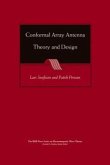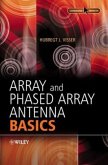- Gebundenes Buch
- Merkliste
- Auf die Merkliste
- Bewerten Bewerten
- Teilen
- Produkt teilen
- Produkterinnerung
- Produkterinnerung
Stutzman's 3rd edition of Antenna Theory and Design provides a more pedagogical approach with a greater emphasis on computational methods. New features include additional modern material to make the text more exciting and relevant to practicing engineers; new chapters on systems, low-profile elements and base station antennas; organizational changes to improve understanding; more details to selected important topics such as microstrip antennas and arrays; and expanded measurements topic.
Andere Kunden interessierten sich auch für
![Antenna Theory & Design Antenna Theory & Design]() Robert S. ElliottAntenna Theory & Design211,99 €
Robert S. ElliottAntenna Theory & Design211,99 €![Finite Antenna Arrays and Fss Finite Antenna Arrays and Fss]() Benedikt A. MunkFinite Antenna Arrays and Fss295,99 €
Benedikt A. MunkFinite Antenna Arrays and Fss295,99 €![Smart Antennas Smart Antennas]() T. K. SarkarSmart Antennas203,99 €
T. K. SarkarSmart Antennas203,99 €![Conformal Array Antenna Theory and Design Conformal Array Antenna Theory and Design]() Lars JoseffssonConformal Array Antenna Theory and Design193,99 €
Lars JoseffssonConformal Array Antenna Theory and Design193,99 €![Planar Antennas for Wireless Communications Planar Antennas for Wireless Communications]() Kin-Lu WongPlanar Antennas for Wireless Communications213,99 €
Kin-Lu WongPlanar Antennas for Wireless Communications213,99 €![Array and Phased Array Antenna Basics Array and Phased Array Antenna Basics]() Hubregt VisserArray and Phased Array Antenna Basics205,99 €
Hubregt VisserArray and Phased Array Antenna Basics205,99 €![Antennas for Portable Devices Antennas for Portable Devices]() Zhi Ning Chen (ed.)Antennas for Portable Devices153,99 €
Zhi Ning Chen (ed.)Antennas for Portable Devices153,99 €-
-
-
Stutzman's 3rd edition of Antenna Theory and Design provides a more pedagogical approach with a greater emphasis on computational methods. New features include additional modern material to make the text more exciting and relevant to practicing engineers; new chapters on systems, low-profile elements and base station antennas; organizational changes to improve understanding; more details to selected important topics such as microstrip antennas and arrays; and expanded measurements topic.
Hinweis: Dieser Artikel kann nur an eine deutsche Lieferadresse ausgeliefert werden.
Hinweis: Dieser Artikel kann nur an eine deutsche Lieferadresse ausgeliefert werden.
Produktdetails
- Produktdetails
- Verlag: Wiley & Sons
- Artikelnr. des Verlages: 14557664000
- 3. Aufl.
- Seitenzahl: 848
- Erscheinungstermin: 22. Mai 2012
- Englisch
- Abmessung: 265mm x 189mm x 33mm
- Gewicht: 1340g
- ISBN-13: 9780470576649
- ISBN-10: 0470576642
- Artikelnr.: 33869040
- Herstellerkennzeichnung
- Libri GmbH
- Europaallee 1
- 36244 Bad Hersfeld
- gpsr@libri.de
- Verlag: Wiley & Sons
- Artikelnr. des Verlages: 14557664000
- 3. Aufl.
- Seitenzahl: 848
- Erscheinungstermin: 22. Mai 2012
- Englisch
- Abmessung: 265mm x 189mm x 33mm
- Gewicht: 1340g
- ISBN-13: 9780470576649
- ISBN-10: 0470576642
- Artikelnr.: 33869040
- Herstellerkennzeichnung
- Libri GmbH
- Europaallee 1
- 36244 Bad Hersfeld
- gpsr@libri.de
WARREN L. STUTZMAN received his BS in electrical engineering and AB in mathematics degrees from the University of Illinois in 1964 and received MS and Ph.D. degrees in electrical engineering from Ohio State University in 1965 and 1969, respectively. Dr. Stutzman has been on the electrical engineering faculty of Virginia Polytechnic Institute and State University since 1969 and has served as the director of the Antenna Group from its beginning in 1983 until 2001. He served two terms as Interim Department Head. He is currently Principal Investigator for the AWINN (Advanced Wireless Integrated Navy Network) research program sponsored by the Office of Naval Research. He is co-author of the textbook Antenna Theory and Design, John Wiley, 1981 and 1998, and author of Polarization in Electromagnetic Systems, Artech House, 1993. He is a Fellow of the IEEE and served as President of the IEEE Antennas and Propagation Society in 1992.
Chapter 1 Introduction 1
1.1 The History of Antennas 1
1.2 What Is an Antenna and When Is it Used? 10
1.3 How Antennas Radiate 13
1.4 The Four Antenna Types 17
Chapter 2 Antenna Fundamentals 23
2.1 Fundamentals of Electromagnetics 23
2.2 Solution of Maxwell's Equations for Radiation Problems 27
2.3 The Ideal Dipole 32
2.4 Radiation Patterns 36
2.5 Directivity and Gain 50
2.6 Antenna Impedance 56
2.7 Radiation Efficiency 60
2.8 Antenna Polarization 61
Chapter 3 Simple Radiating Systems 70
3.1 Electrically Small Dipoles 70
3.2 Half-Wave Dipoles 73
3.3 Monopoles and Image Theory 75
3.4 Small Loop Antennas and Duality 81
3.5 Two-Element Arrays 89
Chapter 4 System Applications for Antennas 100
4.1 Introduction 100
4.2 Receiving Properties of Antennas 100
4.3 Antenna Noise and Radiometry 103
4.4 Antennas in Communication Systems 107
4.5 Antennas In Wireless Communication Systems 116
4.6 Antennas in Radar Systems 122
4.7 Antennas As Unintentional Radiators 123
Chapter 5 Line Sources 128
5.1 The Uniform Line Source 128
5.2 Tapered Line Sources 137
5.3 Fourier Transform Relations Between the Far-Field Pattern and the
Source Distribution 142
5.4 Fast Wave And Slow Wave Distributions 143
5.5 Superdirective Line Sources 145
Chapter 6 Wire Antennas 151
6.1 Dipole Antennas 151
6.2 Folded Dipole Antennas 161
6.3 Yagi-Uda Antennas 166
6.4 Feeding Wire Antennas 175
6.5 Loaded Wire Antennas 186
6.6 Ground Plane Backed Wire Antennas 190
6.7 Wire Antennas Above an Imperfect Ground Plane 198
6.8 Large Loop Antennas 205
Chapter 7 Broadband Antennas 218
7.1 Introduction 218
7.2 Traveling-Wave Wire Antennas 220
7.3 Helical Antennas 225
7.4 Biconical Antennas 233
7.5 Sleeve Antennas 239
7.6 Principles of Frequency-Independent Antennas 243
7.7 Spiral Antennas 245
7.8 Log-Periodic Antennas 251
7.9 Wideband EMC Antennas 261
7.10 Ultra-Wideband Antennas 264
Chapter 8 Array Antennas 271
8.1 Introduction 271
8.2 The Array Factor for Linear Arrays 272
8.3 Uniformly Excited, Equally Spaced Linear Arrays 278
8.4 The Complete Array Pattern and Pattern Multiplication 286
8.5 Directivity of Uniformly Excited, Equally Spaced Linear Arrays 293
8.6 Nonuniformly Excited, Equally Spaced Linear Arrays 298
8.7 Mutual Coupling in Arrays 303
8.8 Multidimensional Arrays 311
8.9 Phased Arrays and Array Feeding Techniques 314
8.10 Elements for Arrays 327
8.11 Wideband Phased Arrays 332
Chapter 9 Aperture Antennas 344
9.1 Radiation from Apertures and Huygens' Principle 344
9.2 Rectangular Apertures 353
9.3 Techniques for Evaluating Gain 360
9.4 Rectangular Horn Antennas 368
9.5 Circular Apertures 385
9.6 Reflector Antennas 391
9.7 Feed Antennas for Reflectors 416
9.8 Lens Antennas 424
Chapter 10 Antenna Synthesis 433
10.1 The Antenna Synthesis Problem 433
10.2 Line Source Shaped Beam Synthesis Methods 437
10.3 Linear Array Shaped Beam Synthesis Methods 440
10.4 Low Side Lobe, Narrow Main Beam Synthesis Methods 446
10.5 The Iterative Sampling Method 459
Chapter 11 Low-Profile Antennas and Personal Communication Antennas 465
11.1 Introduction 465
11.2 Microstrip Antenna Elements 466
11.3 Microstrip Arrays 478
11.4 Microstrip Leaky Wave Antennas 481
11.5 Fundamental Limits on Antenna Size 488
11.6 Antennas for Compact Devices 498
11.7 Dielectric Resonator Antennas 512
11.8 Near Fields of Electrically Large Antennas 519
11.9 Human Body Effects on Antenna Performance 523
11.10 Radiation Hazards 526
Chapter 12 Terminal and Base Station Antennas for Wireless Applications 536
12.1 Satellite Terminal Antennas 537
12.2 Base Station Antennas 538
12.3 Mobile Terminal Antennas 545
12.4 Smart Antennas 549
12.5 Adaptive and Spatial Filtering Antennas 553
Chapter 13 Antenna Measurements 559
13.1 Reciprocity and Antenna Measurements 559
13.2 Pattern Measurement and Antenna Ranges 564
13.3 Gain Measurement 571
13.4 Polarization Measurement 576
13.5 Field Intensity Measurement 580
13.6 Mobile Radio Antenna Measurements 582
13.7 Rules for Experimental Investigations 583
Chapter 14 CEM for Antennas: The Method of Moments 587
14.1 General Introduction to CEM 587
14.2 Introduction to the Method of Moments 590
14.3 Pocklington's Integral Equation 591
14.4 Integral Equations and Kirchhoff's Network Equations 594
14.5 Source Modeling 596
14.6 Weighted Residuals and the Method of Moments 601
14.7 Two Alternative Approaches to the Method of Moments 606
14.8 Formulation and Computational Considerations 610
14.9 Calculation of Antenna and Scatterer Characteristics 618
14.10 The Wire Antenna or Scatterer as an N-Port Network 621
14.11 Antenna Arrays 625
14.12 Radar Cross Section of Antennas 631
14.13 Modeling of Solid Surfaces 636
14.14 Summary 645
Chapter 15 CEM for Antennas: Finite Difference Time Domain Method 652
15.1 Maxwell's Equations for the FDTD Method 654
15.2 Finite Differences and the Yee Algorithm 657
15.3 Cell Size, Numerical Stability, and Dispersion 664
15.4 Computer Algorithm and FDTD Implementation 667
15.5 Absorbing Boundary Conditions 670
15.6 Source Conditions 674
15.7 Near Fields and Far Fields 681
15.8 A Two-Dimensional Example: An E-Plane Sectoral Horn Antenna 682
15.9 Antenna Analysis and Applications 689
15.10 Summary 697
Chapter 16 CEM for Antennas: High-Frequency Methods 700
16.1 Geometrical Optics 701
16.2 Wedge Diffraction Theory 707
16.3 The Ray-Fixed Coordinate System 716
16.4 A Uniform Theory of Wedge Diffraction 718
16.5 E-Plane Analysis of Horn Antennas 722
16.6 Cylindrical Parabolic Reflector Antennas 725
16.7 Radiation by a Slot on a Finite Ground Plane 727
16.8 Radiation by a Monopole on a Finite Ground Plane 730
16.9 Equivalent Current Concepts 732
16.10 A Multiple Diffraction Formulation 735
16.11 Diffraction by Curved Surfaces 737
16.12 Application of UTD to Wireless Mobile Propagation 742
16.13 Extension of Moment Method Using the UTD 745
16.14 Physical Optics 750
16.15 Frequency Dependence of First-Order Scattering Sources 757
16.16 Method of Stationary Phase 760
16.17 Physical Theory of Diffraction 763
16.18 Cylindrical Parabolic Reflector Antennas--PTD 769
16.19 Summary 771
References 771
Problems 773
Appendix A Frequency Bands 781
A.1 Radio Frequency Bands 781
A.2 Television Channel Frequencies (in North America) 781
A.3 Cellular Telephone Bands 782
A.4 Radar Bands 782
Appendix B Material Data and Constants 783
B.1 Conductivities of Good Conductors 783
B.2 Wire Data 783
B.3 Dielectric Constant: Permittivity of Free Space 784
B.4 Permeability of Free Space 784
B.5 Velocity of Light of Free Space 784
B.6 Intrinsic Impedance of Free Space 784
B.7 Properties of Some Common Dielectrics 784
Appendix C Coordinate Systems and Vectors 785
C.1 The Coordinate Systems and Unit Vectors 785
C.2 Vector Identities 786
C.3 Vector Differential Operators 787
Appendix D Trigonometric Relations 789
Appendix E Hyperbolic Relations 791
Appendix F Mathematical Relations 793
F.1 Dirac Delta Function 793
F.2 Binomial Theorem 793
F.3 Bessel Functions 793
F.4 Some Useful Integrals 794
Appendix G Computing Tools for Antennas 795
G.1 Wire Antenna Simulation Packages 795
G.2 Parabolic Reflector Antenna Simulation Packages 796
G.3 Web Sites with Antenna Calculation and Modeling Tools 796
Appendix H Book List 797
H.1 Introduction 797
H.2 Antenna Definitions 797
H.3 Fundamental Books on Antennas 797
H.4 Books on Antennas with Propagation 799
H.5 Books On Antennas With Other Topics 799
H.6 Handbooks and General Reference Books on Antennas 799
H.7 Books on Antenna Measurements 800
H.8 Books on Specific Antenna Topics 801
H.9 Books on Antennas For Specific Applications 805
H.10 Books on Computational Methods for Antennas 807
H.11 Books on Topics Closely Related to Antennas 809
Index 811
1.1 The History of Antennas 1
1.2 What Is an Antenna and When Is it Used? 10
1.3 How Antennas Radiate 13
1.4 The Four Antenna Types 17
Chapter 2 Antenna Fundamentals 23
2.1 Fundamentals of Electromagnetics 23
2.2 Solution of Maxwell's Equations for Radiation Problems 27
2.3 The Ideal Dipole 32
2.4 Radiation Patterns 36
2.5 Directivity and Gain 50
2.6 Antenna Impedance 56
2.7 Radiation Efficiency 60
2.8 Antenna Polarization 61
Chapter 3 Simple Radiating Systems 70
3.1 Electrically Small Dipoles 70
3.2 Half-Wave Dipoles 73
3.3 Monopoles and Image Theory 75
3.4 Small Loop Antennas and Duality 81
3.5 Two-Element Arrays 89
Chapter 4 System Applications for Antennas 100
4.1 Introduction 100
4.2 Receiving Properties of Antennas 100
4.3 Antenna Noise and Radiometry 103
4.4 Antennas in Communication Systems 107
4.5 Antennas In Wireless Communication Systems 116
4.6 Antennas in Radar Systems 122
4.7 Antennas As Unintentional Radiators 123
Chapter 5 Line Sources 128
5.1 The Uniform Line Source 128
5.2 Tapered Line Sources 137
5.3 Fourier Transform Relations Between the Far-Field Pattern and the
Source Distribution 142
5.4 Fast Wave And Slow Wave Distributions 143
5.5 Superdirective Line Sources 145
Chapter 6 Wire Antennas 151
6.1 Dipole Antennas 151
6.2 Folded Dipole Antennas 161
6.3 Yagi-Uda Antennas 166
6.4 Feeding Wire Antennas 175
6.5 Loaded Wire Antennas 186
6.6 Ground Plane Backed Wire Antennas 190
6.7 Wire Antennas Above an Imperfect Ground Plane 198
6.8 Large Loop Antennas 205
Chapter 7 Broadband Antennas 218
7.1 Introduction 218
7.2 Traveling-Wave Wire Antennas 220
7.3 Helical Antennas 225
7.4 Biconical Antennas 233
7.5 Sleeve Antennas 239
7.6 Principles of Frequency-Independent Antennas 243
7.7 Spiral Antennas 245
7.8 Log-Periodic Antennas 251
7.9 Wideband EMC Antennas 261
7.10 Ultra-Wideband Antennas 264
Chapter 8 Array Antennas 271
8.1 Introduction 271
8.2 The Array Factor for Linear Arrays 272
8.3 Uniformly Excited, Equally Spaced Linear Arrays 278
8.4 The Complete Array Pattern and Pattern Multiplication 286
8.5 Directivity of Uniformly Excited, Equally Spaced Linear Arrays 293
8.6 Nonuniformly Excited, Equally Spaced Linear Arrays 298
8.7 Mutual Coupling in Arrays 303
8.8 Multidimensional Arrays 311
8.9 Phased Arrays and Array Feeding Techniques 314
8.10 Elements for Arrays 327
8.11 Wideband Phased Arrays 332
Chapter 9 Aperture Antennas 344
9.1 Radiation from Apertures and Huygens' Principle 344
9.2 Rectangular Apertures 353
9.3 Techniques for Evaluating Gain 360
9.4 Rectangular Horn Antennas 368
9.5 Circular Apertures 385
9.6 Reflector Antennas 391
9.7 Feed Antennas for Reflectors 416
9.8 Lens Antennas 424
Chapter 10 Antenna Synthesis 433
10.1 The Antenna Synthesis Problem 433
10.2 Line Source Shaped Beam Synthesis Methods 437
10.3 Linear Array Shaped Beam Synthesis Methods 440
10.4 Low Side Lobe, Narrow Main Beam Synthesis Methods 446
10.5 The Iterative Sampling Method 459
Chapter 11 Low-Profile Antennas and Personal Communication Antennas 465
11.1 Introduction 465
11.2 Microstrip Antenna Elements 466
11.3 Microstrip Arrays 478
11.4 Microstrip Leaky Wave Antennas 481
11.5 Fundamental Limits on Antenna Size 488
11.6 Antennas for Compact Devices 498
11.7 Dielectric Resonator Antennas 512
11.8 Near Fields of Electrically Large Antennas 519
11.9 Human Body Effects on Antenna Performance 523
11.10 Radiation Hazards 526
Chapter 12 Terminal and Base Station Antennas for Wireless Applications 536
12.1 Satellite Terminal Antennas 537
12.2 Base Station Antennas 538
12.3 Mobile Terminal Antennas 545
12.4 Smart Antennas 549
12.5 Adaptive and Spatial Filtering Antennas 553
Chapter 13 Antenna Measurements 559
13.1 Reciprocity and Antenna Measurements 559
13.2 Pattern Measurement and Antenna Ranges 564
13.3 Gain Measurement 571
13.4 Polarization Measurement 576
13.5 Field Intensity Measurement 580
13.6 Mobile Radio Antenna Measurements 582
13.7 Rules for Experimental Investigations 583
Chapter 14 CEM for Antennas: The Method of Moments 587
14.1 General Introduction to CEM 587
14.2 Introduction to the Method of Moments 590
14.3 Pocklington's Integral Equation 591
14.4 Integral Equations and Kirchhoff's Network Equations 594
14.5 Source Modeling 596
14.6 Weighted Residuals and the Method of Moments 601
14.7 Two Alternative Approaches to the Method of Moments 606
14.8 Formulation and Computational Considerations 610
14.9 Calculation of Antenna and Scatterer Characteristics 618
14.10 The Wire Antenna or Scatterer as an N-Port Network 621
14.11 Antenna Arrays 625
14.12 Radar Cross Section of Antennas 631
14.13 Modeling of Solid Surfaces 636
14.14 Summary 645
Chapter 15 CEM for Antennas: Finite Difference Time Domain Method 652
15.1 Maxwell's Equations for the FDTD Method 654
15.2 Finite Differences and the Yee Algorithm 657
15.3 Cell Size, Numerical Stability, and Dispersion 664
15.4 Computer Algorithm and FDTD Implementation 667
15.5 Absorbing Boundary Conditions 670
15.6 Source Conditions 674
15.7 Near Fields and Far Fields 681
15.8 A Two-Dimensional Example: An E-Plane Sectoral Horn Antenna 682
15.9 Antenna Analysis and Applications 689
15.10 Summary 697
Chapter 16 CEM for Antennas: High-Frequency Methods 700
16.1 Geometrical Optics 701
16.2 Wedge Diffraction Theory 707
16.3 The Ray-Fixed Coordinate System 716
16.4 A Uniform Theory of Wedge Diffraction 718
16.5 E-Plane Analysis of Horn Antennas 722
16.6 Cylindrical Parabolic Reflector Antennas 725
16.7 Radiation by a Slot on a Finite Ground Plane 727
16.8 Radiation by a Monopole on a Finite Ground Plane 730
16.9 Equivalent Current Concepts 732
16.10 A Multiple Diffraction Formulation 735
16.11 Diffraction by Curved Surfaces 737
16.12 Application of UTD to Wireless Mobile Propagation 742
16.13 Extension of Moment Method Using the UTD 745
16.14 Physical Optics 750
16.15 Frequency Dependence of First-Order Scattering Sources 757
16.16 Method of Stationary Phase 760
16.17 Physical Theory of Diffraction 763
16.18 Cylindrical Parabolic Reflector Antennas--PTD 769
16.19 Summary 771
References 771
Problems 773
Appendix A Frequency Bands 781
A.1 Radio Frequency Bands 781
A.2 Television Channel Frequencies (in North America) 781
A.3 Cellular Telephone Bands 782
A.4 Radar Bands 782
Appendix B Material Data and Constants 783
B.1 Conductivities of Good Conductors 783
B.2 Wire Data 783
B.3 Dielectric Constant: Permittivity of Free Space 784
B.4 Permeability of Free Space 784
B.5 Velocity of Light of Free Space 784
B.6 Intrinsic Impedance of Free Space 784
B.7 Properties of Some Common Dielectrics 784
Appendix C Coordinate Systems and Vectors 785
C.1 The Coordinate Systems and Unit Vectors 785
C.2 Vector Identities 786
C.3 Vector Differential Operators 787
Appendix D Trigonometric Relations 789
Appendix E Hyperbolic Relations 791
Appendix F Mathematical Relations 793
F.1 Dirac Delta Function 793
F.2 Binomial Theorem 793
F.3 Bessel Functions 793
F.4 Some Useful Integrals 794
Appendix G Computing Tools for Antennas 795
G.1 Wire Antenna Simulation Packages 795
G.2 Parabolic Reflector Antenna Simulation Packages 796
G.3 Web Sites with Antenna Calculation and Modeling Tools 796
Appendix H Book List 797
H.1 Introduction 797
H.2 Antenna Definitions 797
H.3 Fundamental Books on Antennas 797
H.4 Books on Antennas with Propagation 799
H.5 Books On Antennas With Other Topics 799
H.6 Handbooks and General Reference Books on Antennas 799
H.7 Books on Antenna Measurements 800
H.8 Books on Specific Antenna Topics 801
H.9 Books on Antennas For Specific Applications 805
H.10 Books on Computational Methods for Antennas 807
H.11 Books on Topics Closely Related to Antennas 809
Index 811
Chapter 1 Introduction 1
1.1 The History of Antennas 1
1.2 What Is an Antenna and When Is it Used? 10
1.3 How Antennas Radiate 13
1.4 The Four Antenna Types 17
Chapter 2 Antenna Fundamentals 23
2.1 Fundamentals of Electromagnetics 23
2.2 Solution of Maxwell's Equations for Radiation Problems 27
2.3 The Ideal Dipole 32
2.4 Radiation Patterns 36
2.5 Directivity and Gain 50
2.6 Antenna Impedance 56
2.7 Radiation Efficiency 60
2.8 Antenna Polarization 61
Chapter 3 Simple Radiating Systems 70
3.1 Electrically Small Dipoles 70
3.2 Half-Wave Dipoles 73
3.3 Monopoles and Image Theory 75
3.4 Small Loop Antennas and Duality 81
3.5 Two-Element Arrays 89
Chapter 4 System Applications for Antennas 100
4.1 Introduction 100
4.2 Receiving Properties of Antennas 100
4.3 Antenna Noise and Radiometry 103
4.4 Antennas in Communication Systems 107
4.5 Antennas In Wireless Communication Systems 116
4.6 Antennas in Radar Systems 122
4.7 Antennas As Unintentional Radiators 123
Chapter 5 Line Sources 128
5.1 The Uniform Line Source 128
5.2 Tapered Line Sources 137
5.3 Fourier Transform Relations Between the Far-Field Pattern and the
Source Distribution 142
5.4 Fast Wave And Slow Wave Distributions 143
5.5 Superdirective Line Sources 145
Chapter 6 Wire Antennas 151
6.1 Dipole Antennas 151
6.2 Folded Dipole Antennas 161
6.3 Yagi-Uda Antennas 166
6.4 Feeding Wire Antennas 175
6.5 Loaded Wire Antennas 186
6.6 Ground Plane Backed Wire Antennas 190
6.7 Wire Antennas Above an Imperfect Ground Plane 198
6.8 Large Loop Antennas 205
Chapter 7 Broadband Antennas 218
7.1 Introduction 218
7.2 Traveling-Wave Wire Antennas 220
7.3 Helical Antennas 225
7.4 Biconical Antennas 233
7.5 Sleeve Antennas 239
7.6 Principles of Frequency-Independent Antennas 243
7.7 Spiral Antennas 245
7.8 Log-Periodic Antennas 251
7.9 Wideband EMC Antennas 261
7.10 Ultra-Wideband Antennas 264
Chapter 8 Array Antennas 271
8.1 Introduction 271
8.2 The Array Factor for Linear Arrays 272
8.3 Uniformly Excited, Equally Spaced Linear Arrays 278
8.4 The Complete Array Pattern and Pattern Multiplication 286
8.5 Directivity of Uniformly Excited, Equally Spaced Linear Arrays 293
8.6 Nonuniformly Excited, Equally Spaced Linear Arrays 298
8.7 Mutual Coupling in Arrays 303
8.8 Multidimensional Arrays 311
8.9 Phased Arrays and Array Feeding Techniques 314
8.10 Elements for Arrays 327
8.11 Wideband Phased Arrays 332
Chapter 9 Aperture Antennas 344
9.1 Radiation from Apertures and Huygens' Principle 344
9.2 Rectangular Apertures 353
9.3 Techniques for Evaluating Gain 360
9.4 Rectangular Horn Antennas 368
9.5 Circular Apertures 385
9.6 Reflector Antennas 391
9.7 Feed Antennas for Reflectors 416
9.8 Lens Antennas 424
Chapter 10 Antenna Synthesis 433
10.1 The Antenna Synthesis Problem 433
10.2 Line Source Shaped Beam Synthesis Methods 437
10.3 Linear Array Shaped Beam Synthesis Methods 440
10.4 Low Side Lobe, Narrow Main Beam Synthesis Methods 446
10.5 The Iterative Sampling Method 459
Chapter 11 Low-Profile Antennas and Personal Communication Antennas 465
11.1 Introduction 465
11.2 Microstrip Antenna Elements 466
11.3 Microstrip Arrays 478
11.4 Microstrip Leaky Wave Antennas 481
11.5 Fundamental Limits on Antenna Size 488
11.6 Antennas for Compact Devices 498
11.7 Dielectric Resonator Antennas 512
11.8 Near Fields of Electrically Large Antennas 519
11.9 Human Body Effects on Antenna Performance 523
11.10 Radiation Hazards 526
Chapter 12 Terminal and Base Station Antennas for Wireless Applications 536
12.1 Satellite Terminal Antennas 537
12.2 Base Station Antennas 538
12.3 Mobile Terminal Antennas 545
12.4 Smart Antennas 549
12.5 Adaptive and Spatial Filtering Antennas 553
Chapter 13 Antenna Measurements 559
13.1 Reciprocity and Antenna Measurements 559
13.2 Pattern Measurement and Antenna Ranges 564
13.3 Gain Measurement 571
13.4 Polarization Measurement 576
13.5 Field Intensity Measurement 580
13.6 Mobile Radio Antenna Measurements 582
13.7 Rules for Experimental Investigations 583
Chapter 14 CEM for Antennas: The Method of Moments 587
14.1 General Introduction to CEM 587
14.2 Introduction to the Method of Moments 590
14.3 Pocklington's Integral Equation 591
14.4 Integral Equations and Kirchhoff's Network Equations 594
14.5 Source Modeling 596
14.6 Weighted Residuals and the Method of Moments 601
14.7 Two Alternative Approaches to the Method of Moments 606
14.8 Formulation and Computational Considerations 610
14.9 Calculation of Antenna and Scatterer Characteristics 618
14.10 The Wire Antenna or Scatterer as an N-Port Network 621
14.11 Antenna Arrays 625
14.12 Radar Cross Section of Antennas 631
14.13 Modeling of Solid Surfaces 636
14.14 Summary 645
Chapter 15 CEM for Antennas: Finite Difference Time Domain Method 652
15.1 Maxwell's Equations for the FDTD Method 654
15.2 Finite Differences and the Yee Algorithm 657
15.3 Cell Size, Numerical Stability, and Dispersion 664
15.4 Computer Algorithm and FDTD Implementation 667
15.5 Absorbing Boundary Conditions 670
15.6 Source Conditions 674
15.7 Near Fields and Far Fields 681
15.8 A Two-Dimensional Example: An E-Plane Sectoral Horn Antenna 682
15.9 Antenna Analysis and Applications 689
15.10 Summary 697
Chapter 16 CEM for Antennas: High-Frequency Methods 700
16.1 Geometrical Optics 701
16.2 Wedge Diffraction Theory 707
16.3 The Ray-Fixed Coordinate System 716
16.4 A Uniform Theory of Wedge Diffraction 718
16.5 E-Plane Analysis of Horn Antennas 722
16.6 Cylindrical Parabolic Reflector Antennas 725
16.7 Radiation by a Slot on a Finite Ground Plane 727
16.8 Radiation by a Monopole on a Finite Ground Plane 730
16.9 Equivalent Current Concepts 732
16.10 A Multiple Diffraction Formulation 735
16.11 Diffraction by Curved Surfaces 737
16.12 Application of UTD to Wireless Mobile Propagation 742
16.13 Extension of Moment Method Using the UTD 745
16.14 Physical Optics 750
16.15 Frequency Dependence of First-Order Scattering Sources 757
16.16 Method of Stationary Phase 760
16.17 Physical Theory of Diffraction 763
16.18 Cylindrical Parabolic Reflector Antennas--PTD 769
16.19 Summary 771
References 771
Problems 773
Appendix A Frequency Bands 781
A.1 Radio Frequency Bands 781
A.2 Television Channel Frequencies (in North America) 781
A.3 Cellular Telephone Bands 782
A.4 Radar Bands 782
Appendix B Material Data and Constants 783
B.1 Conductivities of Good Conductors 783
B.2 Wire Data 783
B.3 Dielectric Constant: Permittivity of Free Space 784
B.4 Permeability of Free Space 784
B.5 Velocity of Light of Free Space 784
B.6 Intrinsic Impedance of Free Space 784
B.7 Properties of Some Common Dielectrics 784
Appendix C Coordinate Systems and Vectors 785
C.1 The Coordinate Systems and Unit Vectors 785
C.2 Vector Identities 786
C.3 Vector Differential Operators 787
Appendix D Trigonometric Relations 789
Appendix E Hyperbolic Relations 791
Appendix F Mathematical Relations 793
F.1 Dirac Delta Function 793
F.2 Binomial Theorem 793
F.3 Bessel Functions 793
F.4 Some Useful Integrals 794
Appendix G Computing Tools for Antennas 795
G.1 Wire Antenna Simulation Packages 795
G.2 Parabolic Reflector Antenna Simulation Packages 796
G.3 Web Sites with Antenna Calculation and Modeling Tools 796
Appendix H Book List 797
H.1 Introduction 797
H.2 Antenna Definitions 797
H.3 Fundamental Books on Antennas 797
H.4 Books on Antennas with Propagation 799
H.5 Books On Antennas With Other Topics 799
H.6 Handbooks and General Reference Books on Antennas 799
H.7 Books on Antenna Measurements 800
H.8 Books on Specific Antenna Topics 801
H.9 Books on Antennas For Specific Applications 805
H.10 Books on Computational Methods for Antennas 807
H.11 Books on Topics Closely Related to Antennas 809
Index 811
1.1 The History of Antennas 1
1.2 What Is an Antenna and When Is it Used? 10
1.3 How Antennas Radiate 13
1.4 The Four Antenna Types 17
Chapter 2 Antenna Fundamentals 23
2.1 Fundamentals of Electromagnetics 23
2.2 Solution of Maxwell's Equations for Radiation Problems 27
2.3 The Ideal Dipole 32
2.4 Radiation Patterns 36
2.5 Directivity and Gain 50
2.6 Antenna Impedance 56
2.7 Radiation Efficiency 60
2.8 Antenna Polarization 61
Chapter 3 Simple Radiating Systems 70
3.1 Electrically Small Dipoles 70
3.2 Half-Wave Dipoles 73
3.3 Monopoles and Image Theory 75
3.4 Small Loop Antennas and Duality 81
3.5 Two-Element Arrays 89
Chapter 4 System Applications for Antennas 100
4.1 Introduction 100
4.2 Receiving Properties of Antennas 100
4.3 Antenna Noise and Radiometry 103
4.4 Antennas in Communication Systems 107
4.5 Antennas In Wireless Communication Systems 116
4.6 Antennas in Radar Systems 122
4.7 Antennas As Unintentional Radiators 123
Chapter 5 Line Sources 128
5.1 The Uniform Line Source 128
5.2 Tapered Line Sources 137
5.3 Fourier Transform Relations Between the Far-Field Pattern and the
Source Distribution 142
5.4 Fast Wave And Slow Wave Distributions 143
5.5 Superdirective Line Sources 145
Chapter 6 Wire Antennas 151
6.1 Dipole Antennas 151
6.2 Folded Dipole Antennas 161
6.3 Yagi-Uda Antennas 166
6.4 Feeding Wire Antennas 175
6.5 Loaded Wire Antennas 186
6.6 Ground Plane Backed Wire Antennas 190
6.7 Wire Antennas Above an Imperfect Ground Plane 198
6.8 Large Loop Antennas 205
Chapter 7 Broadband Antennas 218
7.1 Introduction 218
7.2 Traveling-Wave Wire Antennas 220
7.3 Helical Antennas 225
7.4 Biconical Antennas 233
7.5 Sleeve Antennas 239
7.6 Principles of Frequency-Independent Antennas 243
7.7 Spiral Antennas 245
7.8 Log-Periodic Antennas 251
7.9 Wideband EMC Antennas 261
7.10 Ultra-Wideband Antennas 264
Chapter 8 Array Antennas 271
8.1 Introduction 271
8.2 The Array Factor for Linear Arrays 272
8.3 Uniformly Excited, Equally Spaced Linear Arrays 278
8.4 The Complete Array Pattern and Pattern Multiplication 286
8.5 Directivity of Uniformly Excited, Equally Spaced Linear Arrays 293
8.6 Nonuniformly Excited, Equally Spaced Linear Arrays 298
8.7 Mutual Coupling in Arrays 303
8.8 Multidimensional Arrays 311
8.9 Phased Arrays and Array Feeding Techniques 314
8.10 Elements for Arrays 327
8.11 Wideband Phased Arrays 332
Chapter 9 Aperture Antennas 344
9.1 Radiation from Apertures and Huygens' Principle 344
9.2 Rectangular Apertures 353
9.3 Techniques for Evaluating Gain 360
9.4 Rectangular Horn Antennas 368
9.5 Circular Apertures 385
9.6 Reflector Antennas 391
9.7 Feed Antennas for Reflectors 416
9.8 Lens Antennas 424
Chapter 10 Antenna Synthesis 433
10.1 The Antenna Synthesis Problem 433
10.2 Line Source Shaped Beam Synthesis Methods 437
10.3 Linear Array Shaped Beam Synthesis Methods 440
10.4 Low Side Lobe, Narrow Main Beam Synthesis Methods 446
10.5 The Iterative Sampling Method 459
Chapter 11 Low-Profile Antennas and Personal Communication Antennas 465
11.1 Introduction 465
11.2 Microstrip Antenna Elements 466
11.3 Microstrip Arrays 478
11.4 Microstrip Leaky Wave Antennas 481
11.5 Fundamental Limits on Antenna Size 488
11.6 Antennas for Compact Devices 498
11.7 Dielectric Resonator Antennas 512
11.8 Near Fields of Electrically Large Antennas 519
11.9 Human Body Effects on Antenna Performance 523
11.10 Radiation Hazards 526
Chapter 12 Terminal and Base Station Antennas for Wireless Applications 536
12.1 Satellite Terminal Antennas 537
12.2 Base Station Antennas 538
12.3 Mobile Terminal Antennas 545
12.4 Smart Antennas 549
12.5 Adaptive and Spatial Filtering Antennas 553
Chapter 13 Antenna Measurements 559
13.1 Reciprocity and Antenna Measurements 559
13.2 Pattern Measurement and Antenna Ranges 564
13.3 Gain Measurement 571
13.4 Polarization Measurement 576
13.5 Field Intensity Measurement 580
13.6 Mobile Radio Antenna Measurements 582
13.7 Rules for Experimental Investigations 583
Chapter 14 CEM for Antennas: The Method of Moments 587
14.1 General Introduction to CEM 587
14.2 Introduction to the Method of Moments 590
14.3 Pocklington's Integral Equation 591
14.4 Integral Equations and Kirchhoff's Network Equations 594
14.5 Source Modeling 596
14.6 Weighted Residuals and the Method of Moments 601
14.7 Two Alternative Approaches to the Method of Moments 606
14.8 Formulation and Computational Considerations 610
14.9 Calculation of Antenna and Scatterer Characteristics 618
14.10 The Wire Antenna or Scatterer as an N-Port Network 621
14.11 Antenna Arrays 625
14.12 Radar Cross Section of Antennas 631
14.13 Modeling of Solid Surfaces 636
14.14 Summary 645
Chapter 15 CEM for Antennas: Finite Difference Time Domain Method 652
15.1 Maxwell's Equations for the FDTD Method 654
15.2 Finite Differences and the Yee Algorithm 657
15.3 Cell Size, Numerical Stability, and Dispersion 664
15.4 Computer Algorithm and FDTD Implementation 667
15.5 Absorbing Boundary Conditions 670
15.6 Source Conditions 674
15.7 Near Fields and Far Fields 681
15.8 A Two-Dimensional Example: An E-Plane Sectoral Horn Antenna 682
15.9 Antenna Analysis and Applications 689
15.10 Summary 697
Chapter 16 CEM for Antennas: High-Frequency Methods 700
16.1 Geometrical Optics 701
16.2 Wedge Diffraction Theory 707
16.3 The Ray-Fixed Coordinate System 716
16.4 A Uniform Theory of Wedge Diffraction 718
16.5 E-Plane Analysis of Horn Antennas 722
16.6 Cylindrical Parabolic Reflector Antennas 725
16.7 Radiation by a Slot on a Finite Ground Plane 727
16.8 Radiation by a Monopole on a Finite Ground Plane 730
16.9 Equivalent Current Concepts 732
16.10 A Multiple Diffraction Formulation 735
16.11 Diffraction by Curved Surfaces 737
16.12 Application of UTD to Wireless Mobile Propagation 742
16.13 Extension of Moment Method Using the UTD 745
16.14 Physical Optics 750
16.15 Frequency Dependence of First-Order Scattering Sources 757
16.16 Method of Stationary Phase 760
16.17 Physical Theory of Diffraction 763
16.18 Cylindrical Parabolic Reflector Antennas--PTD 769
16.19 Summary 771
References 771
Problems 773
Appendix A Frequency Bands 781
A.1 Radio Frequency Bands 781
A.2 Television Channel Frequencies (in North America) 781
A.3 Cellular Telephone Bands 782
A.4 Radar Bands 782
Appendix B Material Data and Constants 783
B.1 Conductivities of Good Conductors 783
B.2 Wire Data 783
B.3 Dielectric Constant: Permittivity of Free Space 784
B.4 Permeability of Free Space 784
B.5 Velocity of Light of Free Space 784
B.6 Intrinsic Impedance of Free Space 784
B.7 Properties of Some Common Dielectrics 784
Appendix C Coordinate Systems and Vectors 785
C.1 The Coordinate Systems and Unit Vectors 785
C.2 Vector Identities 786
C.3 Vector Differential Operators 787
Appendix D Trigonometric Relations 789
Appendix E Hyperbolic Relations 791
Appendix F Mathematical Relations 793
F.1 Dirac Delta Function 793
F.2 Binomial Theorem 793
F.3 Bessel Functions 793
F.4 Some Useful Integrals 794
Appendix G Computing Tools for Antennas 795
G.1 Wire Antenna Simulation Packages 795
G.2 Parabolic Reflector Antenna Simulation Packages 796
G.3 Web Sites with Antenna Calculation and Modeling Tools 796
Appendix H Book List 797
H.1 Introduction 797
H.2 Antenna Definitions 797
H.3 Fundamental Books on Antennas 797
H.4 Books on Antennas with Propagation 799
H.5 Books On Antennas With Other Topics 799
H.6 Handbooks and General Reference Books on Antennas 799
H.7 Books on Antenna Measurements 800
H.8 Books on Specific Antenna Topics 801
H.9 Books on Antennas For Specific Applications 805
H.10 Books on Computational Methods for Antennas 807
H.11 Books on Topics Closely Related to Antennas 809
Index 811








